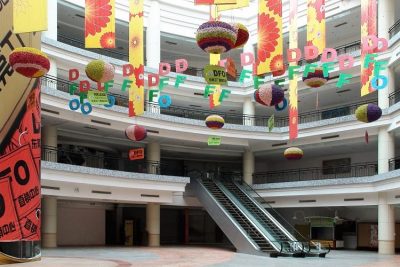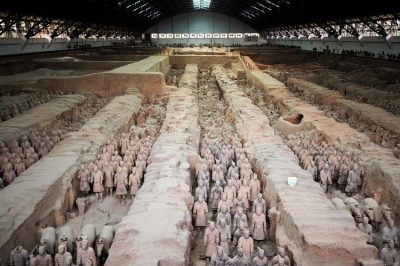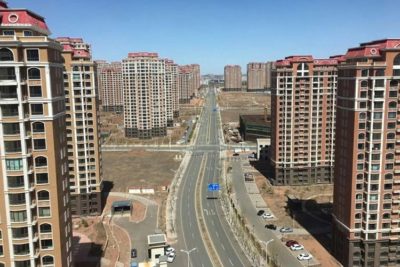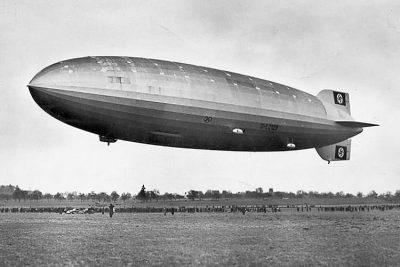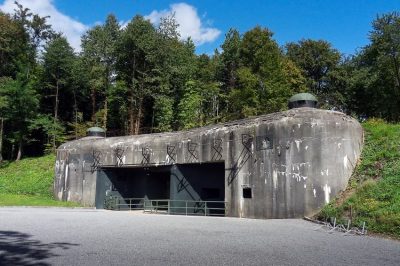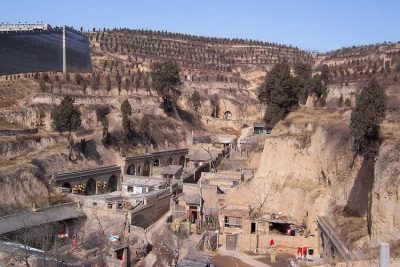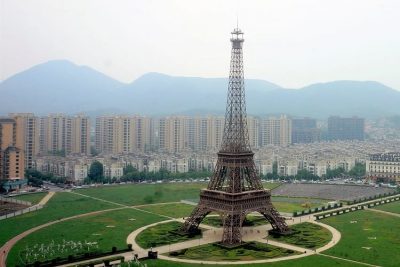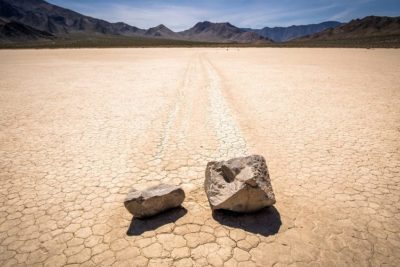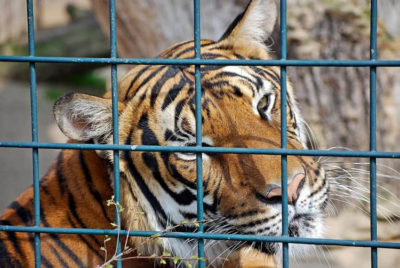The post Traditional Yaodong, Shaanxi Province: The Cave Dwellings in Which Many Chinese People Still Live appeared first on .
]]>
Yaodong, traditional cave houses in Shanxi, China. (Meier & Poehlmann / Wikimedia Commons)
Ever wondered what it might feel like to live in a cave? Well, you don’t have to take a time machine back to the prehistoric era. Just head over to Shaanxi province in China and get a first-hand experience. More than 30 million people in China still live in cave dwellings, and it is particularly commonplace in the Shaanxi area. Given the climate of the region—very cold winters and very hot summers — living in caves is ecologically and economically sustainable.
The cave houses in China’s Shaanxi Province

The exterior of the cave house. (Gary Todd / Flickr)
The cave dwellings in Shaanxi province are known as yaodong in the Chinese language. These are man-made caves, not naturally occurring ones, but they do align well with the natural terrain.
The Loess Plateau of Shaanxi is notable for its soft, yellow soil that is relatively easy to excavate. Taking advantage of this, the local people began the practice of excavating caves on the slopes on the hillsides or in the valleys. One of the main advantages of this was that it freed up the level lands for agricultural purposes.
The yaodongs are, on the whole, stable structures, and many of them have withstood earthquakes over the centuries.
The first yaodongs, according to existing Chinese historical records, were built around 4000 years ago in Northern China. The Xia Dynasty, which ruled from 2100 to 1600 BCE, was in power at the time. Yaodongs became more well-designed and widespread during the Ming Dynasty, between 1368 and 1644, and the Qing Dynasty, between 1644 and 1912.
Other types of cave houses in China’s Shaanxi Province
Apart from the caves in the hill or valley slopes, people also build yaodongs in flat areas in square-shaped pits that they first excavate in the ground. The pits may be five to eight meters in depth. The yaodong is excavated in the wall of the pit and the rest of the area is used as a sunken courtyard.

A sunken courtyard type cave dwelling. (Gary Todd / Flickr)
Some people also build stand alone yaodongs. They built an arched framework of stone or bricks and use soil to build a flat, thick roof.
The traditional structure of the Yaodong
The original yaodong consisted of a semi-circular entrance and a single long hall with a width of three to four meters and a depth of six to eight meters. The hall often has a vaulted ceiling and a sleeping platform known as kang. This latter is made from damped earth and it is usually built over the space for the cooking fire.
As the yaodong design developed, people began cutting lateral openings into the excavated caves. In this manner, a single family or an extended family could have a yaodong that consisted of several interconnected rooms. Some yaodongs also comprise of several interconnected stories.

The interior of a yaodong. (Gary Todd / Flickr)
Many yaodongs have yards in front that are surrounded by mud walls. The inhabitants can relax and catch some sun in these yards, raise a small garden, and use it for washing, drying clothes, and cooking.
Traditional yaodongs, while keeping their inhabitants safe from the weather, are often rather primitive. The interior is gloomy as the only source of natural light is from the semi-circular opening in the front. This opening is covered with rice paper or colourful rugs and, so, lets in limited light. For more illumination, the dwellers have to depend on candles or on the hearth fire.
People also have to use external outhouses or do their business in chamber pots and empty these outside later.
These days, only a few yaodongs have retained all their traditional trappings.
Modern Yaodongs
Most people, who still live in yaodongs in Shaanxi province, have modernized their cave dwellings. The yaodongs now have brick and concrete reinforcements, and some may extend outwards with attractive facades. Additionally, these modern yaodongs have indoor plumbing with running water, tiled bathrooms, and well-installed kitchens. They also have electricity and modern appliances like TV, computer, refrigerator, washing machine, air-conditioner, and more. Some of these yaodongs are, in fact, quite on par with many luxury apartments.
Economic and ecological advantage of Yaodongs
The principal advantage of yaodongs is that they suit the climate of Shaanxi province. The thick soil encasing of the yaodongs offers them excellent insulation. The local people call it ‘Dong Nuan Xia Liang.’ In wintertime, the soil retains heat and it is, therefore, warm and cosy inside the cave. On the other hand, in the summertime, the soil cools down and ensures that the cave interior remains bearable. Thanks to this natural insulation, people living in the yaodongs don’t generally need to install coolers or heaters and can thereby save on energy costs.
Furthermore, excavating the caves is inexpensive and the materials used for its further construction —wood, stone, brick, etc —are natural and locally found or locally made.
Famous Chinese people who have lived in caves
Mao Tse-tung
In the 1930s, the Chinese communists carried out their famous retreat, known as the Long March. At the end of it, near Yanan, Mao Tse-tung and his associates lived in yaodongs for quite a while. They even set up the classrooms for their Red Army in the yaodongs. The writer, Edgar Snow, mentions this in his book “Red Star Over China.” According to him, they used stones and bricks to make desks and chairs for the students and clay and limestone for the blackboards and walls.
Xi Jinping
Before he became the President of China and one of the most powerful men in the world, Xi Jinping endured a great many hardships. His father had been one of the leading communist revolutionaries and had also been the Vice Premier of China. However, during the Cultural Revolution in China, his father fell from political grace, and as a result, both the immediate and extended Xi family suffered. Shunned everywhere for being his father’s son, it seemed that Xi Jinping was not going to have a bright future in the CCP in Beijing or elsewhere. His father sent him to Liangjiahe, a remote village in Shaanxi province, and he lived there in a yaodong for seven years.
Tourists can now view the cave in which Xi Jinping lived, but don’t expect to get any juicy gossip. Given the widespread interest in his life, the Chinese government has now instructed the inhabitants of Liangjiahe village to not talk to journalists or outsiders about Xi Jinping’s sojourn there. Even so, some of the elderly villagers have let it be known how impressed they were with the young Xi Jinping—he was only 15 years old when he arrived at the village—and how he lived as well as was possible in a yaodong with almost none of the current modern amenities.
Future of cave houses in China’s Shaanxi Province
The cave houses in Shaanxi province are all in the rural areas. Most of them have been in the same families for generations and it is likely this trend will continue. Economic development in Shaanxi province has enriched many of its inhabitants, so they don’t need to sell their yaodongs and have, in fact, been able to modernize them into luxury dwellings.
However, as more and more people move to the cities for work, education, and other lifestyle reasons, they end up buying or renting apartments there. Many of the rural yaodongs will then be relegated to a weekend or holiday homes. Only some of the older generation will live in them on a full-time basis. These include those who never left their rural homes and those who decided to return after many years of living in urban apartments.
In any case, very few are available for rent or purchase. People prefer to hold on to their traditional homes. Moreover, if any are available, the rents or prices are generally very expensive. Some yaodongs are available for as low as $30 per month, but these are the primitive types without any plumbing and electricity.
Aside from Shaanxi province, you can also see yaodongs in Gansu and Henan provinces.
Enjoyed this article? Also, check out “The South China Mall: Why Did the Largest Mall in the World Fail?“
Fact Analysis:
STSTW Media strives to deliver accurate information through careful research. However, things can go wrong. If you find the above article inaccurate or biased, please let us know at [email protected].
RELATED
The post Traditional Yaodong, Shaanxi Province: The Cave Dwellings in Which Many Chinese People Still Live appeared first on .
]]>The post Rape of Nanking is One of the Most Brutal and Forgotten Genocides of 20th Century appeared first on .
]]>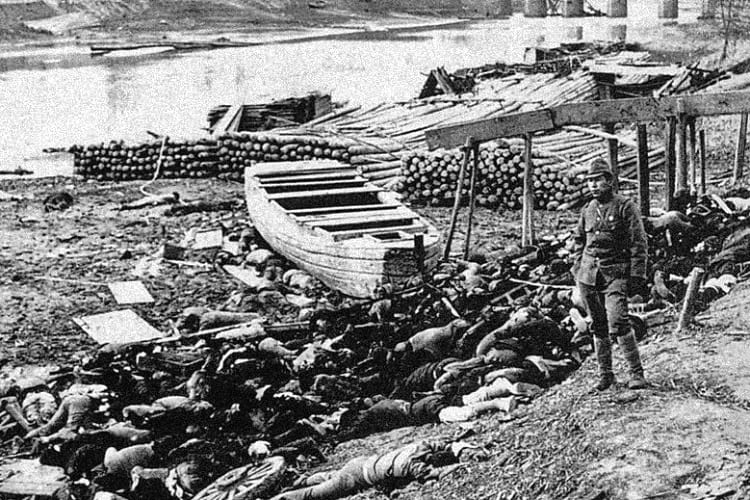
Dead bodies lying on the bank of Qinhuai River during Rape of Nanking Massacre. (Originally Moriyasu Murase)
History is full of Holocaust -i.e., Hitler’s Nazi Germany committed an act of genocide by killing six million Jews across Europe. This happened between the World War II years of 1941 and 1945. But does history speak of the Rape of Nanking in the same breath? Probably, no.
The Rape of Nanking is one of the most brutal acts of 20th-century genocides of world history that took place in December of 1937.
The invading Japanese ran over Nanking, which was the capital of China at that time, butchering at least 300,000 Chinese civilians and raping 20,000 to 80,000 women. All this happened in a matter of just eight weeks.
As part of the sack of Nanking, the Japanese went on to torture hundreds of thousands of civilians in the Chinese capital.
Journalist Iris Chang wrote a book
Disturbed over this genocide, journalist Iris Chang wrote a book in the subject titled ‘The Rape of Nanking: The Forgotten Holocaust of World War II’. It was published by Basic Books.
It is through this book the modern world came to know of the gory details of the Japanese atrocities in Nanking, China. Until then only a handful of survivors and some others knew about the Rape of Nanking.
Iris Chang claims that Nanking was a laboratory for Japanese soldiers, where they were taught to slaughter unarmed and unresisting civilians. Later, the Japanese are said to have used similar tactics elsewhere in Asia.
Japan failed to acknowledge the genocide
Till today, the Japanese have not acknowledged the genocide. Obviously, the Japanese government is therefore yet to pay reparations to the Chinese for its army’s actions.
The Second Sino-Japanese War
The Imperial Japanese Army marched into Nanking in December 1937, at the peak of the second Sino-Japanese war. Nanking was the then Chinese capital city. (Today Nanking is known as Nanjing) As per historical records, the city was virtually undefended. As a result, soldiers of the Imperial Japanese Army swept through the city killing, raping and torturing thousands of civilians.
The city was devastated after a six-week spree of violence. The International Military Tribunal for the Far East concluded that thousands of Chinese women were raped during the first month of the Japanese occupation.
Before the war
Decades before the genocide, tensions were building up between the Japanese Empire and the Republic of China. These tensions had led to the First Sino-Japanese War between the two in 1894 and 1895 over the Korean Peninsula. At that time the Qing Dynasty was ruling over China.
The Japanese Empire feared the Qing Dynasty’s military presence in Korea. It felt whoever held Korea could control Japan. Japan declared a state of war and annexed the Korean Peninsula from China.
Later, the Russo-Japanese War took place from 1904 to 1905. The two empires fought over the Russian influence over the Korean peninsula and Manchuria. The war came to an end following a treaty which gave Japan official control of Korea and South Manchuria.
After the end of World War I, also known as The Great War, the era of prosperity ended the world over including Japan. To prevent mass starvation following the global economic depression, ultra-nationalists forced the Japanese government to conquer newer territories.
It is in this context, Japan declared war against China and started bombing Nanking from August 15, 1937, onwards. As a result, millions of Chinese turned refugees. They fled the city either by land, boat or train.
Japanese troops first attacked Shanghai
At the same time, the Japanese troops first attacked Shanghai before moving on to Nanking. At Shanghai, the Chinese troops gave strong resistance. Both sides suffered heavy casualties. By November, however, the Japanese captured Shanghai.
Even before the Japanese headed towards Nanking, the Chinese government left for relocation. The then president Lin Sen left the city and left its fate John Rabe, who was the head of the Nazi Party in Germany.

John Heinrich Detlef Rabe. (DrSivle / Wikimedia Commons)
Meanwhile, the Japanese army unleashed their acts of crime on their way to Nanking. They started clubbing, bayoneting Chinese citizens and abducting and raping Chinese women and throwing them into sexual slavery.
Safety Zone in Nanking
Worried over atrocities on the Chinese, a handful of Europeans and Americans formed an International Committee to create a Safety Zone in Nanking. The foreigners had decided to stay put in Nanking and help the Chinese.
As part of the Safety Zone, a small portion of the Nanking city was partitioned off. The area of the safety zone was just two and a half square miles. Within the zone, non-Chinese as well as Chinese were off limits to the invading Japanese forces.
Interestingly, John Rabe struck a truce deal with the Japanese for the safety of Chinese soldiers within the Zone. As per the truce, the Japanese Army to also treat the Chinese soldiers as POWs. But, the Japanese put to death thousands of Chinese – soldiers and civilians alike.
Japanese troops attacked Nanking before dawn
On a fateful day, December 13th, 50,000 Japanese troops attacked Nanking before dawn. Even though the 90,000 Chinese troops outnumbered the Japanese, they collapsed after the enemy deceived and killed them across Nanking.
Throughout the siege of Nanking, the Japanese used Chinese soldiers and civilians for bayonet target practice. Though the massacre was carried on for months, the worst atrocities took place in the first eight weeks itself.
During this period, one could see several beheaded corpses of Chinese victims on the shore of the Qinhuai River that passed through Nanking city. According to writer and journalist Iris Chang, during the massacre, the Japanese army officers inculcated the soldiers to kill. This happened throughout Nanking. As a result, the Japanese soldiers brutally killed people.
Chinese women used as ‘comfort women’
The Japanese soldiers indulged in live burials and killing of women after raping them and using them as ‘comfort women’. Almost 50 years later such women broke their silence and asked the Japanese government for financial compensation. It is not known whether they received the compensation or not.
Swiftly, the Japanese took control of the city and also started to regulate the activities inside the safety zone. In spite of their efforts to eliminate the safe zone, the Japanese failed to do so. Eventually, the zone housed almost 700,000 refugees.
Censorship imposed
Meanwhile, the Japanese imposed a state of censorship over the safe zone. They made attempts to cover up atrocities across Nanking, moderated letters, journals, photos and moving images.
Between March and July of 1938, the genocide was over. The Japanese continued to occupy Nanking through World War II and until they surrendered.
International Military Tribunal
Later in December 1946, after a lengthy trial within the International Military Tribunal for the Far East War, Lieutenant General Tani Hisao of Japan was indicted as a war criminal. On March 10, 1947, he was sentenced to death.
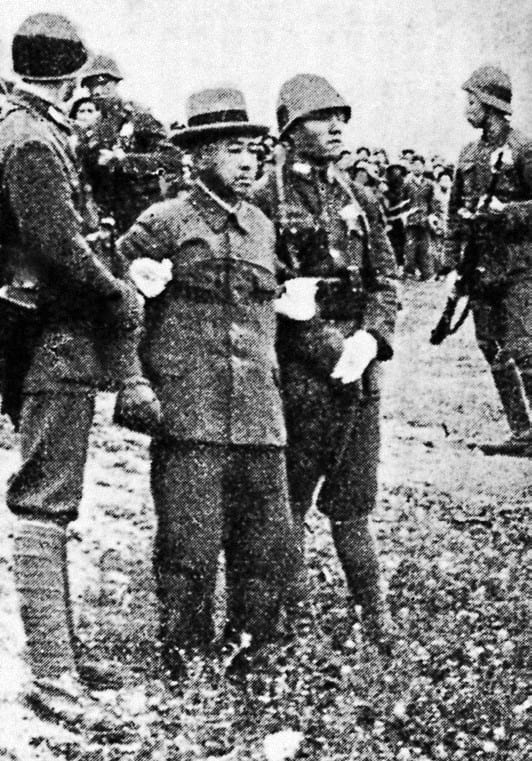
Tani Hisao being escorted for his execution, 1947. (Unknown)
At the same time, the Chinese War Crimes Tribunal convicted three other Japanese officers and sentenced them to death. The officers were Captain Tanaka Gunkichi, Lieutenant Noda Tsuyoshi and Lieutenant Mukai Toshiaki.
Meanwhile, the Tokyo War Crimes Trial charged Commander Matsui Iwane as a Class A war criminal. He was indicted on 29 counts. Further, the former Japanese Foreign Minister Hirota and six others were also found guilty as Class A war criminals. They were hanged to death.
Japan destroyed many records
Sadly though, not many records from the Japanese side were available for the war tribunals, because they were destroyed by Japan in 1945. With the result, the prosecutors, as well as the historians, later failed to get accurate details of the Nanking massacre.
In view of these conditions, even today the genocide continuous to remain a contentious political issue between China and Japan. The Japanese government, as well as the civil society to some extent, denies that the 1937 massacre was genocide.
Killing contest held by two Japanese officers during Rape of Nanking
Perhaps, one of the most notorious atrocities committed in Nanking was the killing contest held by two Japanese officers. As news reports of that era indicate, there was a contest between the two officers to see who could kill 100 Chinese first with a sword.
According to unconfirmed news reports, Prince Asaka, who was the Japanese commander at that time, had a role in the Nanking massacre. After the genocide, Nanking took several decades to recover and later grew into a modern industrial city. Today it is home to China’s largest state-owned companies.
Enjoyed this article? Also, check out “Masada, Israel: Did 967 Rebellious Jews Really Commit Mass Suicide Here?“
Recommended Read:
The Rape of Nanking: The Forgotten Holocaust of World War II | By Iris Chang
Fact Analysis:
STSTW Media strives to deliver accurate information through careful research. However, things can go wrong. If you find the above article inaccurate or biased, please let us know at [email protected].
RELATED
The post Rape of Nanking is One of the Most Brutal and Forgotten Genocides of 20th Century appeared first on .
]]>The post The South China Mall: Why Did the Largest Mall in the World Fail? appeared first on .
]]>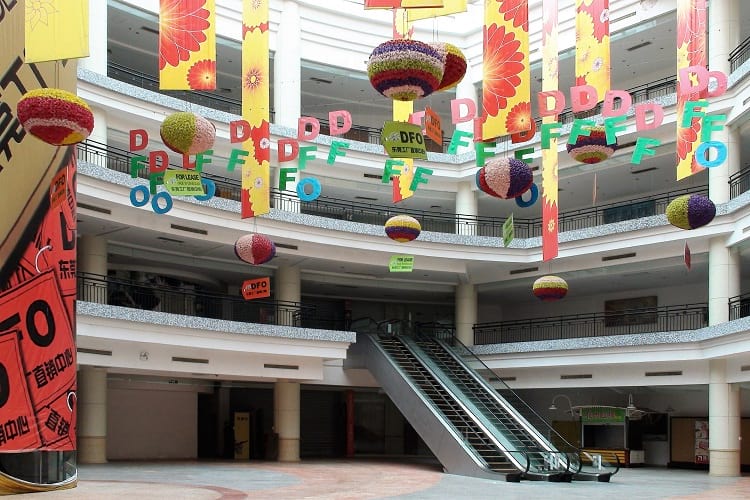
South China Mall. (David290 / Wikimedia Commons)
As China makes its way towards becoming an economic power to reckon with, it is inevitable that it will encounter a few hiccups along the way. One such hiccup was the South China Mall, a massive retail project that failed to live up to its potential.
The South China Mall
When the South China Mall opened in Dongguan in Guangdong Province in China in 2005, the Chinese, as well as the foreign media, celebrated it as the largest mall in the world. With a total building area of 9.6 million square feet and the capacity to host 2350 stores in 7.1 million square feet of this space, it certainly is a behemoth. It is thrice the size of the Mall of America, which is the largest mall in the United States, and was expected to cater to a much larger public. It retained its crown as the largest mall in the world until the Dubai Mall overtook it in terms of area size.
Unfortunately, unlike the Dubai Mall and the Mall of America, the South China Mall has not so far enjoyed the widespread success its developers expected. Despite having pre-leasing agreements with around 1016 stores, the mall opened with only 386 stores. The much-publicized crowd of 200,000 plus people per day never materialized. Over the next ten years, the stores that had leased space in the mall closed or went out of business, and over 99% of the mall space remained empty. It became apparent that the mall was a losing proposition and the Western media began to deride the place as a colossal failure.
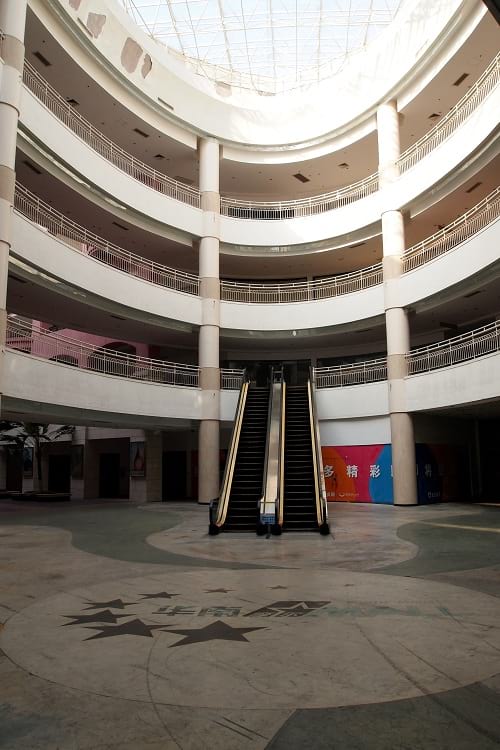
An escalator at South China Mall. (Remko Tanis / Flickr)
Building the biggest mall in the world
The South China Mall began as the brainchild of the Chinese millionaire Hu Guirong. Having made a fortune from instant noodles, he decided to take a hugely ambitious foray into the retail business. The mall was his maiden venture. Since he originally came from Dongguan in Guangdong province and had great pride in his hometown, he wanted to build something so big and amazing that it would put the place on the world map and attract people from all parts of China as well as from around the world.

The now abandoned South China Mall. (Milowent / Wikimedia Commons)
His company, Dongguan Sanyuan Yinghui Investment & Development, took out a financing loan of a billion yuan (around $154 million then) from the Agricultural Bank of China for building the mall.
It is very likely that the loan approval was influenced to a great extent by a feasibility study carried out by Guangzhou’s SMR Group. According to this study, the prospective mall was likely to attract over 200,000 customers per day, and more than a few of these would be shoppers from nearby Guangzhou and Shenzhen. Yes, the researchers who conducted the feasibility study appear to have believed that people would come daily from these cities. That they would prefer to shop at the new mall in another city, rather than at the many malls closer to their homes. The study appears to have been based more on wishful thinking than on practical realities.
In any case, the idea of building the largest mall in the world appealed to the Chinese government as well. Once they had made their approval clear, the bank did not bother further about the project’s economic viability. They just made out the loan to Mr.Hu.
Mr. Hu’s company spent over $1.3 billion in constructing the mall. They sent out design experts to malls around the world to review and gather the best building ideas. The final design of the mall included seven international zones where shoppers could experience the thrill of walking through replicas of the European cities of Amsterdam, Rome, Venice, and Paris, not to mention through faux versions the Caribbean and Egypt. To give visitors a European experience, the builders constructed replicas of famous landmarks like the Arc de Triomphe from Paris, a Venetian canal complete with gondolas, and St. Mark’s bell tower from Venice. Then, to amuse the crowds further, they also added a 1,814 feet roller coaster.
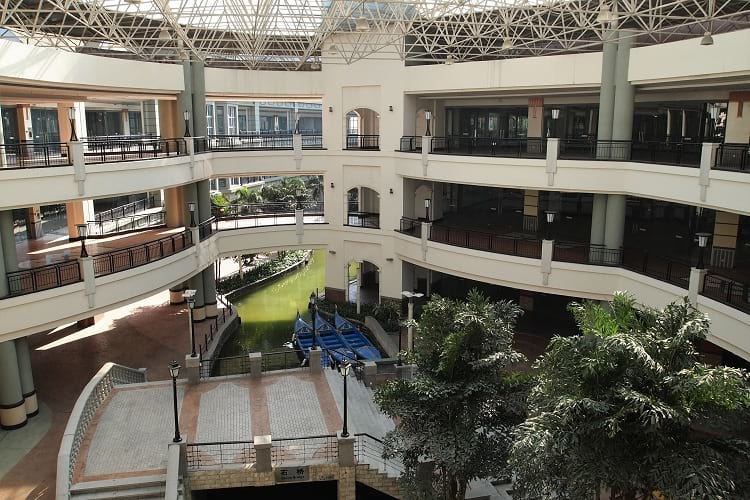
The artificial canal outside New South China Mall. (Remko Tanis / Flickr)
Later, in December 2006, when it became more than apparent that the mall was a failure, Mr. Hu sold a 50% controlling interest in the mall to Peking University’s Founder Group. For all practical purposes, this meant the Chinese government had stepped in and taken over to save face. Given the amount of international publicity that the mall’s opening had generated, they couldn’t very well let the mall fail. In September 2007, the Founder Group changed the mall’s name from ‘South China Mall’ to ‘New South China Mall’ and hoped for the best.
If you build it, doesn’t mean they will come
There is a well-known maxim – Build it, and they will come. That hasn’t been true for the New South China Mall in the ten plus years since its opening. The only places in the mall that see a trickle of visitors are a few restaurants like McDonald’s, KFC, Pizza Hut, and Kungfu, the IMAX film theatre, a small amusement park for children, and a former parking area that is now a Go-Kart track.
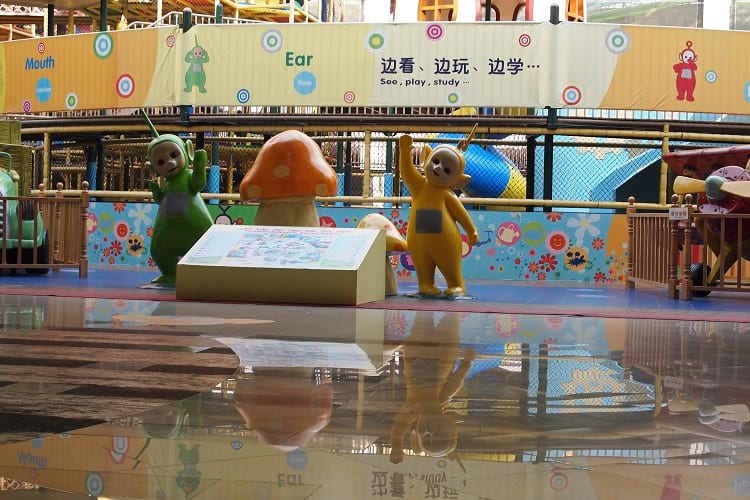
The empty Teletubbies Amusement Park at the mall. (Remko Tanis / Flickr)
The rest of the mall – almost 99% of it – remains empty, and the security guards discourage people from visiting these unoccupied areas. The available staff is, apparently, unable to keep up the complex maintenance, and much of the infrastructure is deteriorating and crumbling. The snaking canal is growing green with algae growth. Old faded decorations remain in place and add to the overall gloom.
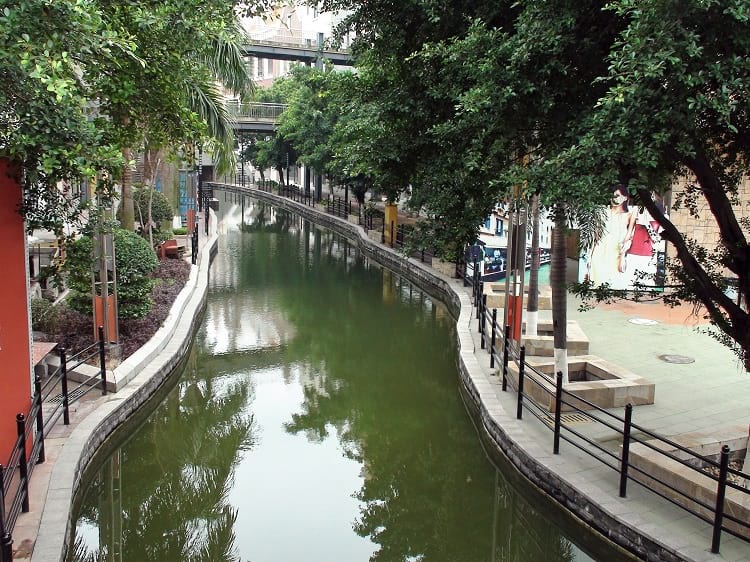
Algae bloom in the artificial canal. (David290 / Wikimedia Commons)
Reasons why the South China Mall failed
While Mr. Hu certainly appears to have had laudable intentions, neither he nor his team seem to have given much thought to various practical aspects regarding the project’s feasibility. For a mall to succeed, it has to be in an area where there are enough consumers, and it must be easy to access. The general public must also find the mall itself simple to navigate. People should be able to move about easily through its various sections without feeling trapped or lost. The New South China Mall scores low of all these aspects.
Let’s consider the issue of demographics
Migrant workers make up a large percentage of the population in Dongguan. They work hard in the nearby factories for average wages of $200 per month and send a good portion of these earnings to their families back home. They have neither the leisure time nor the disposable income to spend in a luxury mall.
Regarding the matter of shoppers visiting from Shenzhen or Guangzhou, that was an unrealistic expectation. There are many large malls in those regions. They, therefore, have no incentive to travel to Dongguan.
Another aspect that the mall developers overlooked is that the Chinese are, in general, savers not spenders. Also, only a minuscule percentage, as compared to the entire population, is wealthy enough to splurge on luxury goods for the snob value.
The issue of location
Built on what was formerly agricultural land in Wanjiang district in Dongguan in Guangdong province, the South China Mall is situated some 55 kilometres away from the city centre in an out of the way location that is not easy to reach. To get there from Dongguan, the city residents must travel for about two hours and, moreover, change a few buses to complete the journey. And after that, since none of the local buses go directly to the mall, they have to get off about one kilometre away and walk for 15 to 20 minutes to get to the mall. The bus fare for this distance is not cheap. Taking a taxi is even more expensive and necessitates paying toll fees to the Dongguan Development Company Limited.
Various journalists and travellers from outside China have found reaching the mall to be a big headache. Doubly so, as the locals were unable to give them the exact directions. For all practical purposes, the largest mall in the world is not even on the radar of most people in Dongguan.
Other issues plaguing the mall
Malls generally rely on big-name stores to act as anchor stores to draw in the crowds. In the case of the South China Mall, while several big-name stores did have a pre-lease agreement with the mall management, they never took up tenancy at the mall. Likewise, Shangri-La Hotels reneged on their promise to open 5-star facilities in the mall complex.
Can the biggest mall in the world resurrect?
Anything’s possible, so who knows? At present, the mall management is concentrating on attracting the local Chinese middle-class, and this might prove to be a more successful strategy.
Enjoyed this article? Also, check out “Kangbashi, Ordos – Ghost City? Economic Ingenuity? Or Both?“.
Fact Analysis:
STSTW Media strives to deliver accurate information through careful research. However, things can go wrong. If you find the above article inaccurate or biased, please let us know at [email protected].
RELATED
The post The South China Mall: Why Did the Largest Mall in the World Fail? appeared first on .
]]>The post China’s ‘One Belt, One Road’ – The Economic Project That Might Reshape the World appeared first on .
]]>
China in Red, the members of the Asian Infrastructure Investment Bank in orange. The 6 proposed corridors in black. (Lommes / Wikimedia Commons)
In ancient times, the Silk Road was famous as the trading route along which China carried out extensive commerce with the rest of the world. This is now being revived as the ‘One Belt, One Road’ initiative or, as it is known in some quarters, as the New Silk Road. Passing across land and sea through around seventy countries, this initiative will reinvigorate their economies and bring about a considerable change in global trade. Also, most probably, it will cause a spectacular shift in political power from the West to the East.
“A journey of a thousand miles begins with a single step”, said Confucius a very long time ago.
His native country, China, has already taken that step and are now well on their way towards becoming an economic world power.
Bruno Macaes’ book ‘Road to China takes a look at what is most certainly the most interesting development of the present century—the implementation of China’s Belt and Road Strategy.
“At home the initiative was not called the “New Silk Road,” but “One Belt, One Road.” Its scope was so large that the timeline for its realization had been fixed at more than thirty years, with the first phase of the project to be concluded in 2021 and the project as a whole realized by 2049.”
Hardly a day has gone by in recent times, when the mainstream media as well as the alternative media hasn’t had something to say about China’s growing stature. Quite a bit of it is of the type purposely intended to set alarm bells ringing across the length and breadth of India. And, of course, the pealing is meant to scare everyone in the West as well.
Most of this scaremongering comes to us from the Western media and for obvious reasons. China is shaking up the Occident’s Tree of Accepted Tradition. From the way the geopolitical winds are shifting, it even looks like they might turn it into a Bonsai.
China’s long-term plan of economic cooperation
On March 8, 2015 Foreign Minister Wang Yi dismissed comparisons of the initiative to the US-sponsored Marshall Plan. For one, the Belt and Road was meant to usher in a new model of international relations, not to salvage or reconstruct a crumbling European civilization. Second, it would be “the product of inclusive cooperation, not a tool of geopolitics, and must not be viewed with an outdated Cold War mentality.”
The Chinese keep repeating “inclusive cooperation” and “economic cooperation”in regard to their mammoth project. They have been busy building diplomatic relations in countries across Asia, Africa and Europe that involve “building factories, roads, bridges, ports, airports and other infrastructure as well as electric power grids, telecommunications networks, oil and natural gas pipelines and related projects.”
As per their plan, the ‘One Belt, One Road’ project is going to pass over land and sea through over seventy countries. In all likelihood, it is going to change the economic landscapes of these countries.
“…it will affect every element of global society from shipping to agriculture, digital economy to tourism and politics to culture.”
A win-win situation for both them and China, according to many Chinese and the host country sources.
“Most importantly, it symbolizes a new phase in China’s ambitions as a superpower: to remake the world economy and crown Beijing as the new centre of capitalism and globalization.”
In Pakistan, for instance, the Chinese are constructing fertilizer plants, meat processing plants, and milk processing plants. They are also investing in agriculture with high yield seeds and high-tech irrigation. Furthermore, they mean to develop transport and storage facilities in major Pakistani cities.
Criticism of the One Belt, One Road plan
Detractors, however, point out that the greater focus on developing agriculture in Pakistan might turn out to be detrimental to the country’s industrial development.
Another matter of concern is that a completely market-based approach could undermine the state’s authority in making economic decisions for its citizens. This can hold true not just for Pakistan but also for all other countries involved in the project.
Also, many of these countries do not have the economic resources needed to shore up and sustain the ‘One Belt, One Road’ plan on their own. As a result, they will have to take out massive loans from China.The chances of repaying this kind of debt in entirety are likely to be slim or will take a great number of years.
“In April 2018, Li Ruogu, the former president of the Export- Import Bank of China, argued publicly that most of the countries along the routes of the Belt and Road… are already heavily in debt and need sustainable finance and private investment, he said, adding that the countries’ average liability and debt ratios had reached 35 and 126 per cent, respectively, far above the globally recognized warning lines.”
There are others in China that are not exactly happy with the way their foreign policy is shaping up.
On August 1, as he voiced his criticism of China’s ambitious foreign policy, a retired professor of physics at Shandong University, Sun Wenguang, was seen being taken away by police, while his voice trailed off: “Regular people are poor, let us not throw our money away in Africa. Throwing money around like this does not do any good for our country or our society.”
India’s concerns about the One Belt, One Road initiative
China’s neighbour, India, is not exactly cheering on their ambitions either. They refused to participate in the Belt and Road summit in May 2017that 30 other countries attended in Beijing.
“The journalist Ashok Malik from the Times of India called the boycott the third most significant decision in the history of Indian foreign policy, after the 1971 decision to back the independence of Bangladesh and the 1998 nuclear tests.”
The Chinese ambassador to India tried to convince the Indians to attend by suggesting that they were opening to renaming the China-Pakistan Economic Corridor. India’s issue with this name is that it implicitly denies Indian claims on Pakistan-occupied Kashmir. According to the Chinese ambassador, the renaming would remove this impression.
The Indian authorities didn’t take the bait and announced:
“…in its current form the Belt and Road will create unsustainable burdens of debt, while one of its segments, the economic corridor linking China and Pakistan, goes through the disputed areas of Gilgit and Baltistan in Pakistan-occupied Kashmir and therefore ignores Indian core concerns on sovereignty and territorial integrity.”
On 13 May 2017, the Indian Ministry of External Affairs released the following statement:
“We are of firm belief that connectivity initiatives must be based on universally recognized international norms, good governance, rule of law, openness, transparency and equality. Connectivity initiatives must follow principles of financial responsibility to avoid projects that would create unsustainable debt burden for communities; balanced eco- logical and environmental protection and preservation standards; transparent assessment of project costs; and skill and technology transfer to help long term running and maintenance of the assets created by local communities.”
A month after the Belt and Road summit, China and India faced off in Doklam and the world watched with bemusement as well as amusement as soldiers from the two countries actually engaged in throwing rocks at each other. Of course, it is a bit more civilized than lobbing nuclear missiles at one another, but, still, not behaviour that is going to foster friendliness and goodwill.
This incident, of course, has done nothing to allay India’s concerns about the proliferation of Chinese naval bases in the Indian Ocean.
“By investing in the Iranian port of Chabahar, India may hope to prevent an outcome where it finds itself isolated from the growing economies on its doorstep, but the limited scale of the project offers a vivid contrast to the mammoth scale of the Belt and Road.”
While India does have many legitimate reasons to be wary of Chinese ambitions, it needs to take care that its foreign policy is ruled entirely by its own interests and is not manipulated by Western powers. It should particularly not allow itself to become a battleground in the economic competition between China and the United States.
In conclusion
In his book on the Belt and Road strategy, Bruno Macaes explores—“Will it herald a new set of universal political values, to rival those of the West?”
Despite all the issues and concerns raised by the “New Silk Road”, most people, in India as well as in other parts of the world, probably won’t have a problem if the “new set of universal political values” even entirely replace “those of the West”.
They might even think that its high time such a change happened.
For more details, read the book:
 Belt and Road: A Chinese World Order | By Bruno Macaes
Belt and Road: A Chinese World Order | By Bruno Macaes
RELATED
The post China’s ‘One Belt, One Road’ – The Economic Project That Might Reshape the World appeared first on .
]]>The post Terracotta Army: An Army to Protect the Dead in Their Afterlife appeared first on .
]]>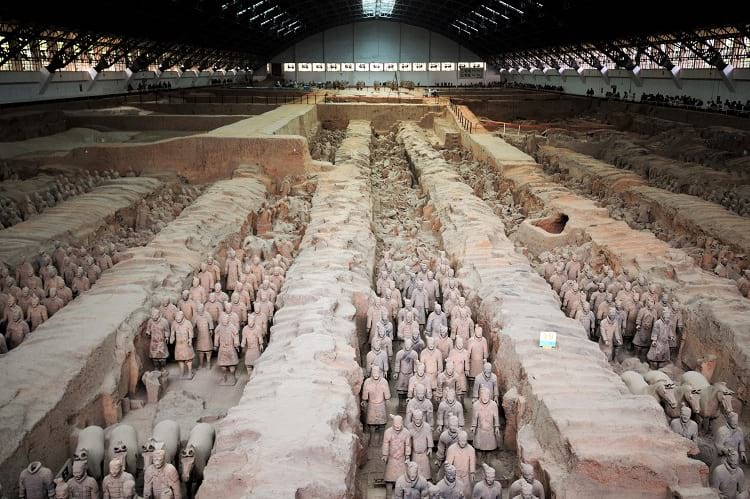
The Terracotta army. (Xiquinho Silva / Flickr)
Over 40 years ago, in March 1974, a group of farmers in China discovered a set of life-size statues made out of earthenware called the Terracotta army, which represented the army of Qin Shi Huang, the First Emperor of China. The statues were discovered by the farmers in Xi’an city of Shaanxi province when they were digging a water well close to the Emperor’s tomb at Mount Li. It is said that the First Emperor had chosen Mount Li as his favored location to be buried at. He believed the location had good terrain as it was brimming with jade and gold mines.
Why the Terracotta army was built?
Similar to the Egyptians, the Chinese too have a belief that once someone dies their tomb is filled with gifts and items they would need for their journey and life after death. This Terracotta army was buried with the first emperor for a similar reason of protecting him in his afterlife.
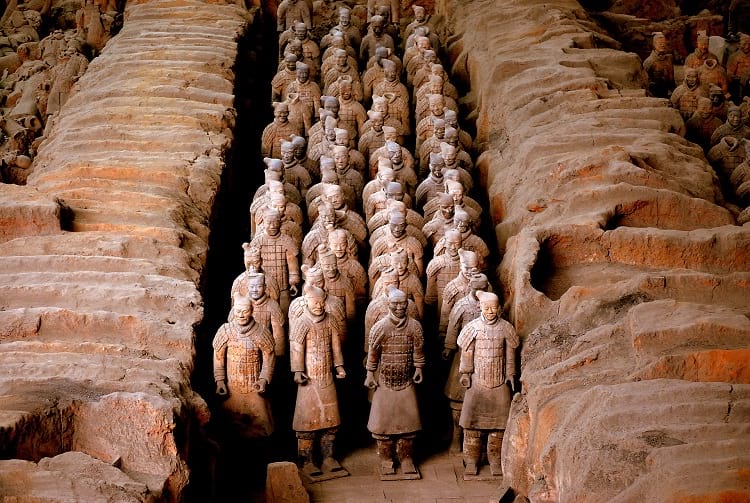
Terracotta warriors. (Peter Griffin / publicdomainpictures.net)
Terracotta Army in China
When the discovery of the farmers was made public, a group of Chinese archaeologists became increasingly interested in the site. Their investigation revealed the largest group of pottery statues ever found. The set of statues that were found were just the tip of the iceberg. The entire underground area supposedly measures 98 sq. kms. It is also estimated that there were 3 pits that held these statues and have more than 8000 soldiers, a combined 650 chariots and horses. The statues there have been constructed in accordance with their role in the army. For instance, generals were the tallest whereas lower-ranking officials were shorter.

Park Geun-hye, former president of South Korea looking at the Terracotta Warriors. (Republic of Korea / Flickr)
Construction of the army
The earthenware statues were made to replicate the original army. The statues included those of chariots, horses, archers, soldiers and their different ranks like armored soldiers, unarmored infantry, cavalry men, drivers of chariots, spear-carrying charioteers, and kneeling archers amongst many more. It is interesting to note that these army figures were manufactured in workshops using the good old assembly line method. Specific parts of the body like the head, arms, legs, and torso were created separately and then assembled. The tough work of the laborers and local craftsmen is visible in the splendor that they created. They used at least 10 different molds to create the faces, upon which clay was added to make each face unique.
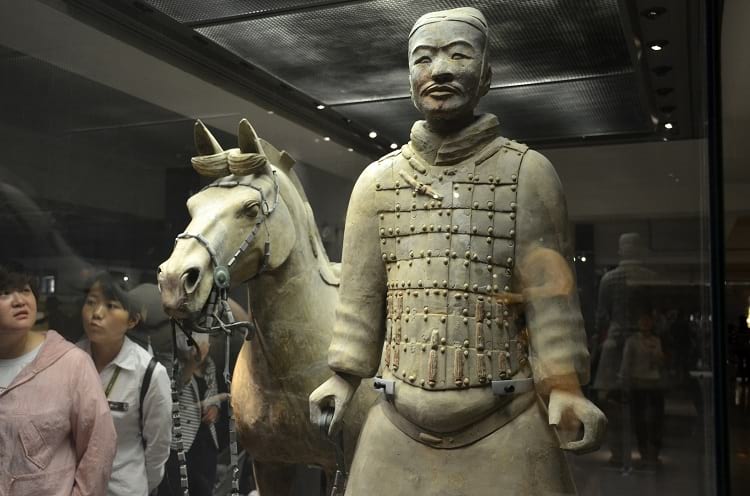
A terracotta soldier with his horse. (shankar s. / Flickr)
A lot of effort was taken to not only make the statues but also place them in the tomb. The statues weren’t just placed haphazardly instead they were placed in the precise military formation in accordance with rank and duty as a real army. In fact, the statues wore real armor and held real weapons to give them a more realistic feel. Unfortunately, a lot of these weapons were looted a little after the army was created. Other weapons seem to have decayed, even though they were coated with a chemical before burial that would protect them from ruin. Some weapons also have engravings on them displaying their date of usage before burial. The army had also been brightly painted to add to the realism. Just like the weapons, the paint too had faded away and just hints of it remain today.
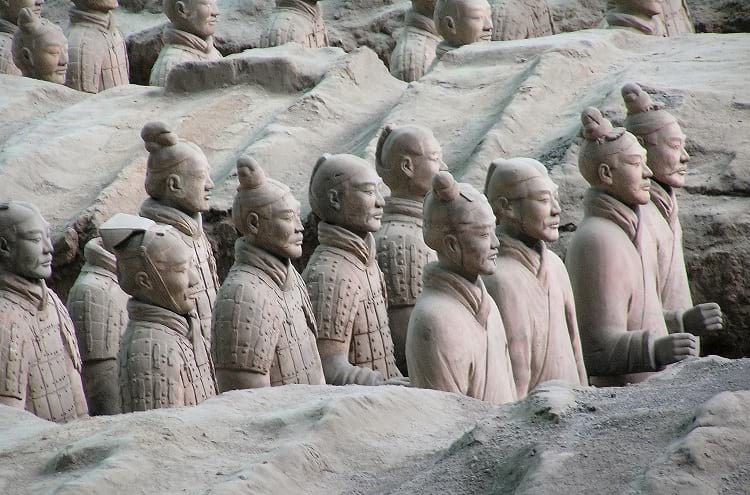
A group of terracotta soldiers. (Robin Chen / Wikimedia Commons)
Attractions linked to the army
Multiple museums, consisting of an enclosed roof structure, have been constructed over the pits of the soldiers. The museum over Pit 1 is over 14260 square meters and was opened to the public in 1979. Whereas the newer museum over Pit 2 is 6,000 sq meters and was opened to the public in 1994. Recently a mini version of the Terracotta army was unearthed from a 2100-year-old pit in China. Statues in this set are as small as 20 cm and aren’t comparable to the original Terracotta army. It is believed to have been built as a toy set for a young prince and has around 500 pieces in its set. Impressively though, the statues in the mini set are arranged just as precisely as the original one.
Enjoyed this article? Also, check out “Traditional Yaodong, Shaanxi Province: The Cave Dwellings in Which Many Chinese People Still Live“.
Fact Analysis:
STSTW Media strives to deliver accurate information through careful research. However, things can go wrong. If you find the above article inaccurate or biased, please let us know at [email protected].
RELATED
The post Terracotta Army: An Army to Protect the Dead in Their Afterlife appeared first on .
]]>The post Replica Constructions of World-Famous Cities and Towns in China: Tianducheng, Thames Town, and Hallstatt appeared first on .
]]>
Replica of Eiffel Tower in Tianducheng, China. (MNXANL / Wikimedia Commons)
The Chinese, historically, considered their country to be the centre of the world and now you can sample the world without straying out of China. Always wanted to visit Paris? England? Hallstatt? That’s alright, China has the almost similar versions of these cities and you are welcome to come and visit.
Replica city and town construction in China
We won’t go into the tired, old cliché about how the Chinese copy everything. You copied too when you learned to read and write. It is a learning process. By building these more or less exact replicas, Chinese construction companies are showing off their chops. They have some of the best talents in the world and are capable of building anything they want. That is more than what people who mock them can do.
The idea of building cities to resemble Western ones came about in 2001. The Shanghai Planning Commission decided to spruce up their city’s ungainly outskirts with nine new municipal suburbs under the ‘One City, Nine Towns’ scheme. They thought that if they built beautiful replicas of Western cities and offered the public the charming lifestyle that came with these cities, the local people would be more than willing to move from overcrowded Shanghai to these brand-new suburbs.
Tianducheng
Tianducheng, which translates to “Sky Capital City,” was once a rural area comprising of rice paddies. It is located in the coastal Zhejiang province, not too far from the provincial capital Hangzhou, and, while you can still see the rice paddies, the area has acquired a French flavour. One of the first things you will notice is the Eiffel Tower. At 354 feet, it is much smaller than the real one in Paris, but it is still tall enough to be eye-catching.

Bird’s-eye view of Tianducheng. (Forgemind ArchiMedia / Flickr)
A meticulously landscaped, residential area, built in the style of the Parisian architect Haussmann and including a version of the Champs Elysées, stretches outward from around the Eiffel Tower. You will find here a very fine reproduction of the famous Bassin de Latone fountain from the Versailles gardens.

Replica of Bassin de Latone fountain. (Forgemind ArchiMedia / Flickr)
The Zhejiang Guangsha Co. Ltd conceived the idea of building Tianducheng as a faux Parisian town in 2007, and they designed it to fit in over 100,000 residents. So far, according to news sources, only about 2000 people have move in to live in Tianducheng. The town, however, gets plenty of domestic and foreign visitors, including newlyweds on their honeymoon. The latter flock here to experience second-hand the original Paris’s overdone reputation as a romantic destination. That they end up having a good time here shows how you don’t have to go far away to experience romance. You can have it in your own country.
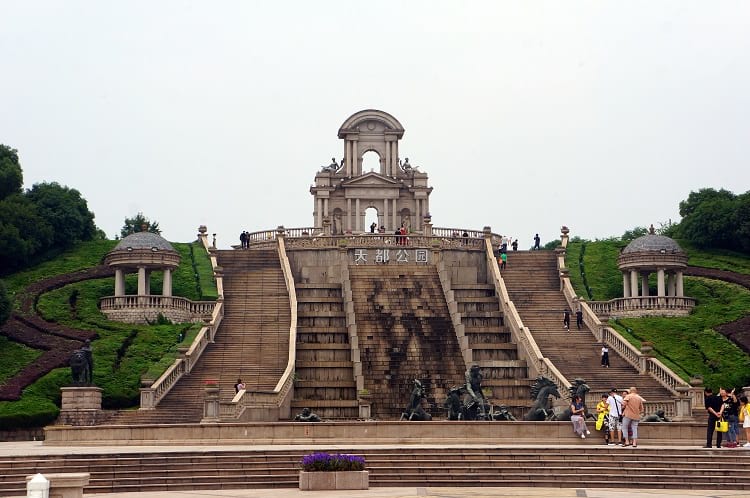
Tiandu Park. (MNXANL / Wikimedia Commons)
Thames Town
The original English town has brick houses and cobblestone streets. China’s Thames Town is in the Songjiang District, about a 40-minute drive to the southwest of Shanghai. The faux Edwardian houses sit amidst real manicured privet hedges and the high street is lined with white Victorian terraces. Visit the Gothic Christ Church in the town square. If you take your dog along, keep him or her leashed and away from the lampposts. They are genuine British items and were imported from Great Britain. If you are hungry, stop by a fish-and-chip shop or walk into a Tudor pub. Want to tell your family about this great town? Put your mobile away and step into an iconic British red phone box. The town planners designed it to fit 10,000 people. There are nine universities in the region and the planners hoped that they would provide the much-needed residents for their new town, along with the middle-class from Shanghai.

Brick house in Thames Town, Songjiang District. (Huai-Chun Hsu/Flickr)
The houses in Thames Town are pricey, however, and out of the reach of most middle-class Chinese. It seems that most of the real estate was snapped up by wealthy Chinese buyers as second homes or as investments. Few of them live in Thames Town year around. There are fewer than 1000 permanent residents and the town appear so empty, it feels like walking through a set that is still waiting for its actors. Thames Town is becoming a ghost town.

Town square, Thames Town. (Huai-Chun Hsu / Flickr)
The builders spent $330 million over a three-year period and the Shanghai Planning Commission, well-pleased with the results, declared that the boundary between China and Europe had now become ephemeral. To be exact, they said: “Visitors will soon be unable to tell where Europe ends and China begins.”
Hallstatt
The original alpine town of Hallstatt is located on the banks of Lake Hallstatt, with tall mountains looming in the background. It is a tiny town, fitted on a narrow strip of land, and with a population of about 900 residents; you could walk through the entire place in 10 minutes. It had salt mines in ancient times, now it depends on its draw as a tourist spot. Its enchanting and picturesque gingerbread houses and the skiing possibilities in the mountains have made it famous enough to draw over 80,000 visitors every year and grant it status as a UNESCO World Heritage site.
Chinese builders, after they had sent their architects to study the real village in great detail, spent $940 million to build a replica of Hallstatt in Huizhou in Guangdong province in southern China. The state-owned, Beijing-based China Minmetals Corporation financed the project and announced they were building it in June 2011. It was at this time that the natives of the real Hallstatt first heard that their tourist village was going to have a doppelganger in China that would also, most likely, draw visitors. Some of the residents were outraged, but the mayor of Hallstatt, Alexander Scheutz, took a more pragmatic view of the matter. The Chinese Hallstatt was almost half built at this time and the Chinese were by no means going to stop their construction work to assuage the hurt feeling of the real Hallstatt dwellers. So why not make the best of the situation? Herr Scheutz reached out to the Chinese, attended the new Hallstatt’s opening ceremony in 2012, and signed a mutually beneficial agreement on cultural exchange to boost tourism at both places. If you visit the website of the real Hallstatt, it mentions the Hallstatt in China. The copywriter was still smarting about the duplication though, it seems, because there is a pointed allusion that only in their town can you experience their truly unique culture.
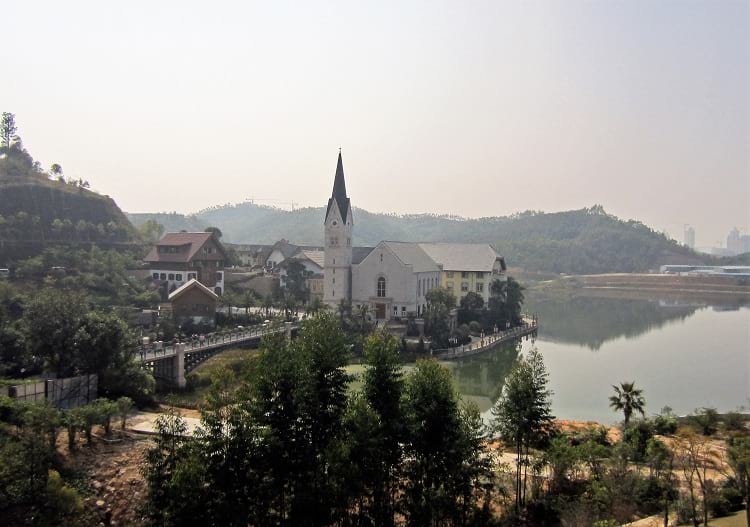
Hallstatt, China. (Hanno Böck / Wikimedia Commons)
Unlike the real Hallstatt, the Chinese Hallstatt is a high-end residential project, but it is attracting tourists as much as the real place. Not residents on the same scale though. As with the other replica towns, the residences here have gone to mainly wealthy Chinese buyers. As few of them appear to have plans to live here on a permanent basis, the new town lies empty most of the time and has become yet another Chinese ghost town.
The future of the Chinese replica towns
If you scour the Western mainstream media, you will come across an almost general gloating over the fact that these towns currently remain mostly unpopulated. Aside from the fact that gloating over other people’s seeming misfortune is not a very nice thing to do, it is far too soon to gloat. From the way China has been developing economically in recent years, it is quite possible that its real estate market will pick up once again. The replica towns will then find more buyers and the Chinese middle-class will have beautiful environs to raise their children in.
In parting though, Chinese builders ought to consider building reproductions of ancient Chinese towns with the marvellous Chinese architecture we see so often in Chinese historical dramas. They are more suited to the landscape and the climate.
Enjoyed this article? Also, check out “Monowi, Nebraska: A Village in Boyd County, United States with a Population of One“.
Fact Analysis:
STSTW Media strives to deliver accurate information through careful research. However, things can go wrong. If you find the above article inaccurate or biased, please let us know at [email protected].
RELATED
The post Replica Constructions of World-Famous Cities and Towns in China: Tianducheng, Thames Town, and Hallstatt appeared first on .
]]>The post The Five Punishments for Chinese Slaves appeared first on .
]]>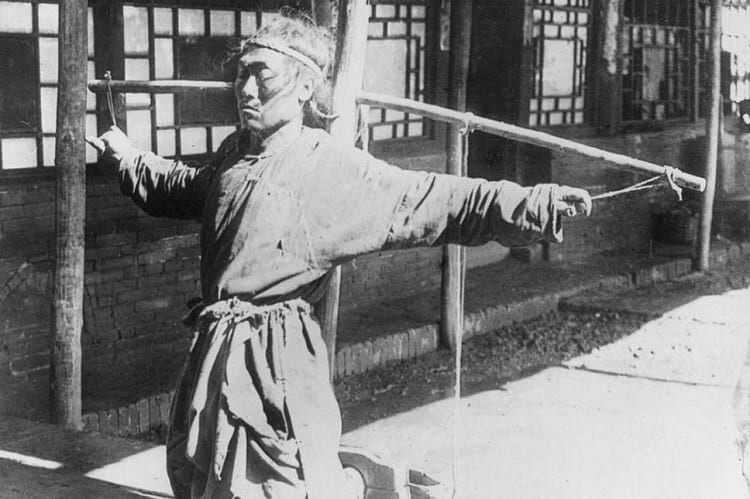
Five Punishments: A Chinese man with hands tied and forced to kneel in public. Circa 1900. (Hawley C. White / Library of Congress)
The journey of mankind has been filled with joy, discovery and wonder. Unfortunately, it has done so alongside pain, evil and shame. To begin the Chinese theme, this connection of opposing sides is symbolic to the famous Chinese philosophy of Yin and Yang, illustrating that conflicting factors are complementary, even dependant on one another. Perhaps the same can be said for crime and punishment, that they are a necessary entity of everyday life.
In much of the world today, forms of torture are frowned upon and even for criminals, alternative forms are encouraged in most countries. It is an attitude that feels right; to save a population from desensitising and returning to a barbaric system of justice. It also inhibits the famous eye for an eye principle which uses a take from me and I take from you legal philosophy.
Anything from money, land or ultimately, an eye. This idiom was first mentioned in the Book of Hammurabi from ancient Mesopotamia – a functioning civilisation which harboured torturous punishments also. Much of the world has changed so much since that time making it hard to imagine that torture was once a mainstay. Commonly practised and an accepted form of punishment in every corner of the world, even within governments. One such place was and is the great land of China.
Punishments for slaves in Old China
This is best proved by the fact that the death sentence is still passed in China today, illustrating that corporal punishment is not designated to the past, and perhaps has a place in the future. There are also the numerous reports that torture techniques are still in practice, for example in secret prisons. China is one of the cradles of civilisation, as one of the oldest continuous cultures in the world.
The first written history comes from a period known as Dynastic China when the Xia Dynasty ruled from 2070 BCE. It is in the centuries before this period when a series of horrifying penalties known as The Five Punishments were written to keep slaves under control and maintain social order. Slavery was a massive cog in the Chinese economic system during this time.
People were born, sold or captured into slavery and their main duties – within a tough life – would be farming. Some slaves would also work with the dynastic families themselves. Around the centuries before the inception of the Xia, these punishments were created although their exact origins are unknown. They seem to have originated from an indigenous people known as the Hmong (Miao) however, a group from the south of China.
The reason for this is that a famed warrior known as Chiyou is heavily involved. His specific clan was unknown but many link it to the Hmong or their allies. For instance, the Sanmiao or the Nine Li. He is regarded as a mythical king and a great warrior. The Xia dynasty adopted these punishments and made them known to their people. They were for men only as women had their own separate punishments which will be listed later.
Five Punishments in Dynastic China
- Face tattooed with permanent ink.
- Nose cut off without anaesthetic
- Removal of foot/feet or kneecap without anaesthetic
- Removal of reproductive organs without anaesthetic
- Death in various forms (including quartering (cutting the body into four pieces), decapitation, drawn out by chariots, strangulation/asphyxiation, slicing by thousands of small cuts.)
In 221 BCE, a ruler called Qin Shi Huang brought about a time known as the Imperial Era. He conquered the dynastic states and made himself Emperor of the collective land known as Qin, later to be called China. During this imperial era his reforms made the punishments less barbaric but none the less still torturous. The improvement of standards is attributed to the teachings of famous philosopher Confucius and his views on human life. The Imperial penalties were as follows,
- Bamboo lashes to the buttocks (the number of lashes depended on the nature of the crime)
- Stick lashes to the back, buttocks or legs
- Penal service (ranging from 1-3 years)
- Exile – (this would be to a remote location such as the island of Hainan to the south, the distance depended on the crime)
- Death (strangulation, slicing or decapitation)

A lawbreaker being whipped while two men restraint him. (Ralph Repo / Flickr)
It must be said that slaves could also pay their way out of these brutal punishments but the prices were extortionate meaning that very few could do so.
For females the punishments were different. There are no concrete reasons why at this point it is simply thought that because China was a patriarchal society in which woman were not held responsible for their crimes. And that they could not suffer as much as male serfs. As follows,
- Forced to grind grain
- Fingers squeezed between sticks
- Beaten with wooden sticks
- Forced suicide
- Solitary confinement (time dependant on crime) or Sequestration (losing assets).
As mentioned, although torture was inherently part of life in all corners of the world, in Chinese culture it seems incredibly more brutal, especially to be so intertwined with government and society, somewhat uniquely. Perhaps the extreme scale of the land and the amount of warring factions gave a higher rise for the need to control. China is such a different world – as are many – for outsiders to comprehend.
There are many works which try to associate the mindset, for example to why their laws arose and why many still continue. Skipping over the nature which brought about torture in the first place (as that would require a tome to even attempt to fathom why) we will look instead at the change from Dynastic to Imperial. When punishments looked to improve after people started becoming enlightened.
This possibly began when the teacher and philosopher Confucius resided and taught. Born in 551 BC his teachings spread more after his life ended and influenced many of his countrymen. The work Crime and Punishment in Ancient China and its Relevance Today explains more,
“Confucianism was designed to maintain civility in the absence of central authority by persuading leaders to create a harmonious society based on the limited use of raw power and punishment.”
Helping Confucianism was the cosmological tradition which was established after his death, around 330 BC during the Warring States Era. This was where many dynasties vied with each other to create an Empire. Like the five punishments, this tradition is based on the five major planets and the elements they represent: Venus (metal), Jupiter (wood), Mercury (water), Mars (fire) and Saturn (Earth). The people used this to monitor agriculture, climate, politics and warfare. In 170 BC a document was found relating these five entities to each other. It is called the Five Star Oracle. Confucianism, as well as the cosmological tradition helped people in this aspect by introducing more moralistic behaviour and by trying to attain a balance among nature. Punishments were not just required for social order but to balance complex natural phenomena. Deborah Cao explains more,
“The cosmologists believed that without an appropriate effort to remedy the social harm caused by a crime, the disturbance of the human order would affect the larger cosmic order of things. Through negative natural phenomena, such as… floods, disturbances of the cosmos would in terms have a negative impact on the human world.”
Although this period certainly lessened torture techniques, the death penalty continued was implemented and advocated by Shang Yang (390 BCE). He founded Chinese Legalism which promoted a strict system. Crime and Punishment in Ancient China and its Relevance Today again explains more.
“The Legalist tradition restored harsh punishment as a way to impose order upon a fragmented society in which local despots had been carrying out arbitrary judgments. But Legalism carried the seeds of its own destruction and required Confucianism to balance it in creating a durable system of governance and justice.”
It looks as though each system – Confucianism and Legalism – worked alongside each other, again like an interconnected Yin and Yang. This was perhaps one of the first documented times that legality and severe punishment went hand-in-hand with socialism. With it, more thought was put into social problems.
Cangue Punishment
Punishment of course continued in other forms. Here is an example of a torture used even until the 20th century, a technique called a Cangue board used in many parts of Asia. It was implemented in other parts of the world also such as England where it was known as a Pillory. The Pillory device, however, would be fixed to the ground while the Cangue could be moved by the recipient if needed. It obviously restricted movements even to the point where people could not feed themselves, resulting in starvation in many cases unless they had friends and family to help them, otherwise strangers. The prisoner would be in the Cangue for as long as the punishment merited, it was mostly the sentence for thieves.

A man being punished by cangue. (John Thomson / Wellcome Images)
These methods continued until China became a Republic in 1912. Then it became westernised and more socialism brought about changes in punishment techniques, making them less brutal. Although as shown with the death penalty, the older traditions remain in China, whereas in other countries the death penalty has been outlawed completely. China, according to Amnesty International accounts for the majority of capital punishments on Earth.
Like many countries, China developed a culture of punishment and torture. However, unlink many countries such as in Western Europe they have kept aspects of it such as the death penalty. There are also many reports regarding punishments similar to the Five going on in secret prisons known as ‘Black Prisons’. The famous bamboo shoot and water torture are a few of the methods practiced.
European installations like the Council of Europe make banning capital punishment a mainstay if a country wishes to join. This is to do with the miscarriage of justice which can occur. More is explained in a deep study by the Economist. It is not just a sentimental gesture, however. Another reason is for keeping political contests fair, as many reports of killing political opponents this way have been reported none more so in China.
“For many emerging democracies, abolishing the death penalty has also been a way to make a decisive break with an authoritarian past, when governments used capital punishment not just to punish criminals but to get rid of political opponents, as China currently seems to be doing in Xinjiang against the province’s Muslims.”
This will long be a contentious element between nations on whether the death penalty is just. For the reasons above it seems a valid argument to abolish it yet oppositely, for serial killers and crowded prisons it becomes more apt. But just where can the line be drawn or known between the two.

Rebels undergoing a slow painful death inside a cage. (Jeff Lea / Wikimedia Commons)
A clearer point can be with torture. It seems simpler in that there is now a consensus flowing through the world that any form of torture is wrong, whatever the crime. It still goes on, that goes without saying but soon hopefully it will be completely resigned to the past. Even reading about these torture techniques is absolutely harrowing, to think of what some people went through, some no doubt innocent. May they rest in peace and be eternally remembered so that the practice of torture is ceased, once and for all.
Enjoyed this article? Also, check out “The Head Crusher – A Renaissance Torture Device for Slow and Incrementally Agonising Punishment“.
Recommended Read:
1. Chinese Language in Law: Code Red | By Deborah Cao
2. Crime and Punishment in Ancient China | By R. H. Van Gulik
Fact Analysis:
STSTW Media strives to deliver accurate information through careful research. However, things can go wrong. If you find the above article inaccurate or biased, please let us know at [email protected].
RELATED
The post The Five Punishments for Chinese Slaves appeared first on .
]]>The post Kowloon Walled City: A Rare Insight of the Once Most Cramped Place on Earth appeared first on .
]]>
A bird’s-eye view of the Kowloon Walled City, 1989. (Ian Lambot / Wikimedia Commons)
Between two stools a man sits on the ground. Similar woe betides a piece of land falling between 2 states, both indifferent it. The land is Kowloon walled city. A 7 acre stretch of in Hong Kong’s coastal area, used and abused for over a thousand years, yet surviving with astonishing malignancy that has no parallel in the history of human civilization.
Imagine a population of 30,000 housed in 300 high rise buildings in 7-acre land space and you would know the construction couldn’t have been legal and civic. In fact, there was little in the name of law and order at this abominable habitat which began with Song Dynasty ( 960-1280) as an outpost for salt trade. Come 1810 and the place was mutated to a coastal fort.
History of Kowloon
In 1842 Dauguang, the emperor of Quing state ceded Hong Kong island, all sans this coastal fort to Britain. Wary of Britain’s colonial march into her sovereignty, the state of Quing used Kowloon, the coastal fort as a nerve centre to protect her independence. In 1898 some additional parts of Hong Kong were handed over to Britain on a 99-year lease. But Kowloon remained out of this deal. Between Britain on one hand and China on other, Kowloon ostensibly belonged to neither of the two.
China though had a token presence in area conditional to noninterference with the overarching rule of British Hong Kong. With the end of Qing dynasty in 1912, the Kowloon walled city fell into the British basket. But British were chary of accepting walled city as their baby and did little for it, that too by way of Church, not state.
During World War II, 1945, Japan invaded Hong Kong and demolished city’s wall to create space for Kai Tak airport for their wartime exigencies. With the surrender of Japan following Hiroshima and Nagasaki bombing China laid claim to this 7-acre human habitation. This period was marked by the civil war in China which led to thousands of Chinese fleeing to Kowloon for British protection.

Aerial photo of Kowloon Walled City. (Jidanni / Wikimedia Commons)
Leaving Kowloon to its fate
By 1947 the refugee influx swelled to 2000. British made half-hearted attempts to drive them out but relented midway and left Kowloon to its own fate and destiny. Long spells of no-rule and misrule made Kowloon a conundrum for Needy, deprived and homeless charting out their own way. Prostitutes, priests, social workers, drug addicts living in close proximity and yet indifferent to each other.
Children’s playground during the day doubled up for strip shows for the sexually hungry crowd at night time. Yet all was not evil. Sanguinely civil was a significant part of dwellers and they walked their way, choosing not to look at the orgy on their sides and behind their back. A lawless land of crime and drug, it got a semblance of civil society, in 1959 a murder was officially deemed as the jurisdiction of the Hong government.
Earlier the Hong Kong police kept a distance from or had only surface indulgence with the walled city which ran on the proxy rule of organised crime syndicates called triads. Mafia ruled the roost till 1973 when dedicated police raids in the area led to arrest of 2,500 goons and a cache of 1800 kg of drugs. Cooperation of law-abiding gentry in the area helped cops rein crime and establish rule of law in the walled city.

Food preparation in unhygienic condition and tight spaces was a common sight inside the city. (Forgemind Archimedia / Flickr)
But by then much had already gone horribly wrong. In the 1960s, 3000 high rise buildings with ham architecture had 30,000 inmates packed in them like sardines. By 1980 the city was bursting at seams and forced the state to put a cap on construction beyond 13 storeys, primarily to clear so airway to Kai Yak Airport.
Apart from serious noise pollution, residents lived in an eerie ambience deprived of sunlight and civic amenities. Unlicensed doctors and dentists operated with impunity, as also many factories and businesses.

A typical passageway in the city during the night. (Ian Lambot / Wikipedia Commons)
The fall of Kowloon Walled City
A persistent pain in the neck of Chinese administration for long, dedicated attempt was made in 1963 to prune the area of lackadaisical structures and up the status of roads and houses and sanitation. Two decades on state mooted radical surgery. On 14th Jan 1987, both Britain and China decided to demolish the area completely and replace it with a suave public park.

The Kowloon Walled City Park. (CPJoseph / Wikimedia Commons)
A massive compensation of US$350 million was cut out to evacuate people from the area to new locations. Actual demolition of it began in 1993 and concluded in 1994.
So, was Kowloon a bad dream destined to be trashed unsung?
Not really. It was sweet home to thousands who lived in the shadow of the underworld and yet made a life out of it. For outsiders, it remained a quintessential curiosity for a freedom unbridled by state watch and fear that lurked in serpentine lanes and bylanes that permeated the city like a jigsaw puzzle.
No wonder the slums and shanties turned high rise towers, the Kowloon walled city found a place in several Hollywood flicks. Martial arts tournament of ‘Blood Sport’ starring Van Damme was shot in precincts of the walled city. Camera shots of this locale in Jackie Chan starrer ‘Crime Story‘ include real scenes of demolition drive. Many other works of art and literature have given quality treatment to Kowloon walled city which now has a more humane face in the shape of Kowloon City Park.
Enjoyed this article? Also, check out “Kangbashi, Ordos – Ghost City? Economic Ingenuity? Or Both?“.
Recommended Visit:
Kowloon Walled City Park | Kowloon City, Hong Kong
Fact Analysis:
STSTW Media strives to deliver accurate information through careful research. However, things can go wrong. If you find the above article inaccurate or biased, please let us know at [email protected].
RELATED
The post Kowloon Walled City: A Rare Insight of the Once Most Cramped Place on Earth appeared first on .
]]>The post Danxia Landform: China’s Rainbow Mountains appeared first on .
]]>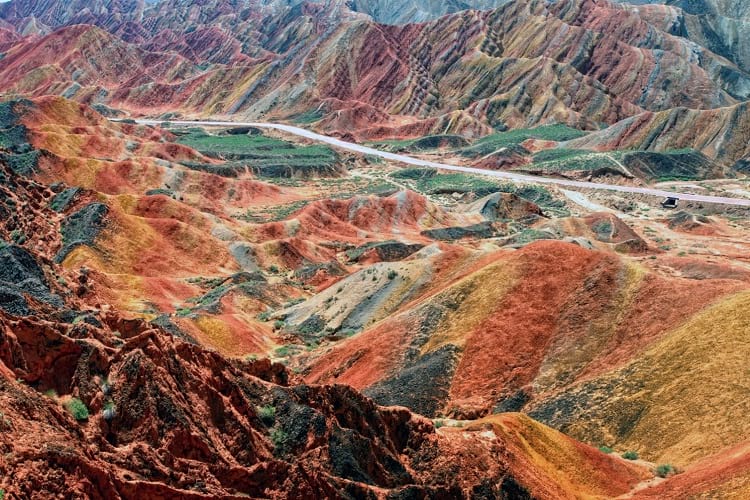
Danxia Landform: Zhangye National Geopark. (lwtt93 / Flickr)
Zhangye Danxia Landform Geological Park is located in the Gansu province of People’s Republic of China. Sprawling over an area of over 200 sq. miles, the park houses a rare geographical feature which draws attention worldwide. The colours on these mountain ranges appear as if they were painted. Danxia, which means ‘rosy cloud,’ is an appropriate name given to this landform seen in China. The Rainbow Mountains belong to Cretaceous era, much before the formation of Himalayan Mountains. The Cretaceous sandstone depositions present in China contained high concentrations of iron and trace minerals that formed the basis of these colours that appear today. About 55 million years ago, the Eurasian plate struck the Indian tectonic plate which led to the formation of the Himalayas and these Rainbow Mountains.
The layered arrangement and horizontal stratigraphy were disrupted by the collision that elevated these hidden sedimentary rocks from the bottom of the Earth. In due course of time, weathering and erosion removed the overlying layers of siliciclastic rocks and brought out the underlying, distinct formations with different mineralogy and chemical composition displaying the striking colour difference seen in the mountains today.

Zhangye National Geopark. (Lwtt93 / Flickr)
Natural coloring agents
The primary deposition found in the area is deep-red sandstone. The red pigmentation of the sandstone is because of iron oxide coating and cementation. Cementation refers to the process in which the pores present between the grains of a constituent are sealed due to a precipitate buildup, binding the grains together in that place. The iron oxide, also known as hematite, is lodged between the grains of the sandstone giving it a deep-red colour. The formation of this iron oxide can be attributed to weathering and a reaction due to exposure to moisture and oxygen, similar to rust. However, a minor change in the chemical composition may cause the variance from the characteristic deep-red colour of sandstone. For example, oxidized limonite or goethite results in yellow or brown staining in sandstones, whereas the presence of iron sulfide imparts metallic yellow colour and chlorite or iron silicate clays forms the green colour. Hence, the upliftment of mountains and formation of deposits of several other salts, coupled with weathering and erosion for millions of years led to the formation of this spectacular Rainbow Mountains that we see today. However, Rainbow mountains form only one part of the whole Danxia landform.
Other attractions at Danxia landform
The Danxia landform is unique to China that can be observed prominently in the sub-tropical region of south-east China, within a crescent-shaped arc that approximately extends to 1700 kilometres. It comprises six regions: Langshan, Danxiashan, Longhushan, Chishui, Taining, and Jianglangshan. The Danxia landform was listed as a World Heritage Site by the UNESCO in 2010. Structures such as peaks, towers, cliffs, valleys, and arches made of deep-red sandstone rock by natural factors is a unique characteristic of the Danxia Landform.

Mount Danxia. (Dunley / Wikimedia Commons)
Planning to visit?
The nearest airport to this natural wonder is in Zhangye City, facilitating the tourists interested in visiting the rainbow mountains or the other parts of Danxia landform. The view is at its best when the sun is fully out with no cloud cover, especially at sunset. Between 6:30 pm and 8:00 pm, the colours attain additional shine and contrast, due to a perfect mix of shadows and light. The officials of the national park provide a bus which moves from one viewpoint to another and tourists are advised to stick to these locations specified by the officials. The ideal time to visit would be summer, between the months July and September, as the best amount of sunlight strikes during this period.
Enjoyed this article? Also, check out “Wave Rock: Where a Massive Prehistoric Wave, Just About to Break, is Etched Permanently in Stone“.
Recommended Visit:
Danxia Landform Geological Park | China
Fact Analysis:
STSTW Media strives to deliver accurate information through careful research. However, things can go wrong. If you find the above article inaccurate or biased, please let us know at [email protected].
RELATED
The post Danxia Landform: China’s Rainbow Mountains appeared first on .
]]>The post Kangbashi, Ordos – Ghost City? Economic Ingenuity? Or Both? appeared first on .
]]>
Empty streets and buildings in Kangbashi District. (© Carla Hajjar / Used With Permission)
China is another world. That is the view of many outsiders when they think about the People’s Republic of China due to the sheer vastness of it. With so much land, masses of inhabitants and many different cultures, intricacies within are often unheard of. As a nation of over 1.379 billion people and 9,596,961 Km² getting your head around the numbers alone is a task enough.
One such intricacy is the emerging abundance of ‘Ghost Towns’; urban areas which resemble a post-apocalyptic movie or post-war zone. And while there are abandoned places on every continent, the sheer scale and increasing amount of these Chinese versions are drawing attention. While they seem to show something sinister or an economic failing, looking into the subject deeper gives another understanding. That they are not ghosts of the past but rather apparitions for the future.
Building a modern sector
In a region known as Inner Mongolia, covered by deserts there is a region called the Ordos with sprawling urban districts. It is home to many extravagant government projects encouraged by a large discovery of coal mines. One such project is called Kangbashi which was set to become the largest district, originally able to accommodate one million people. It was constructed to become the administrative center of Ordos, taking over from neighbouring district Dongsheng. Being closer to water reservoirs is the main reason why.

A quiet street of Kangbashi. (© Carla Hajjar / Used With Permission)
Minus the people, Kangbashi looks relatively ordinary in terms of a modern Chinese city. As it is a young urbanization the government has had to create a sense of history as well as artistry. Monuments have been erected to honour the Mongolian ruler Genghis Khan, a controversial figure who was said to unify the Chinese people.
There are also many statues such as horses relating to nomadic Mongolian traditions. Around them are parks, museums, and shopping malls. The curious case ends here, however. While it is exciting to portray the Chinese city as a mysterious haunt like Pripyat – the town near Chernobyl – Kangbashi is no more than government planning. And judging by China’s success in recent years, presumably clever planning at that.
Just as the old saying goes, “Rome wasn’t built in a day”, Xing Su, an official of Ordos answers the situation. And to look at another, the commonly wrongly quoted “Build it and they [he] will come.” from American baseball movie Field of Dreams seems more pertinent. Kangbashi was created only six years ago. Meaning the abandoned aspect at the moment is simply the transition between construction and inhabitation. Only 100,000 people live there currently (if figures are to be believed) but the government is not worried. Simply put, Kangbashi is not an accident, nor a failure. The Ordos is already a prefecture-level city and this new district is a common economic strategy. As it is cheaper to build a new rather than to refurbish, it will become the new administrative center without the need to change or destroy the old one.
Inhabitation
Officials report that the population is steadily increasing and will continue to do so with 80-90% of apartments having already been sold. This is again a common place in China for future investment, real estate still booming from the wealth created from coal veins.
There is still a problem at the moment, however. Because there is little population it lacks atmosphere and activities causing people to commute from Dongsheng which is the go-to place for shopping and entertainment.
Residents comment that Kangbashi is a car city, the size deeming it not sensible to walk anywhere, making people order online and live in their apartment complexes after work. This leaves the streets empty and while Kangbashi is beautiful, clean and fresh there is not much to do.

An empty mall in Kangbashi. (© Carla Hajjar / Used With Permission)
Government efforts
In effect, the government are looking for ways to improve the city and increase the flow of inhabitants. As the only economic interest is coal, other avenues are necessary to make it a truly functioning metropolis. Car manufacturing plants are being designed and many start-up companies are encouraged too. A national sports stadium has been built which can hold 35,000 spectators as well as a Formula One track in the shape of a horse.
The 2012 Miss World competition was also recently hosted. The ghastly nature of the city is starting to become an idea for adventure tourism with photographers and journalists flocking to the city. They can experience tours that run to the Mausoleum of Genghis Khan, less than 55km away and an area called Xingshawan which has expeditions to the nearby sand dunes. Chinese citizens are also offered many benefits to relocate and become part of the community.

An empty Great Kangbashi bridge. (Popolon / Wikimedia Commons)
Kangbashi has certainly been debunked as a traditional Ghost Town but still holds many of the said qualities. Despite that, it would appear the future is bright here and instead other, older districts such as Dongsheng have the greater danger of becoming abandoned. Alas how long until Kangbashi becomes the next Dongsheng.
Enjoyed this article? Also, check out “Replica Constructions of World-Famous Cities and Towns in China: Tianducheng, Thames Town, and Hallstatt“.
Recommended Visit:
Kangbashi District | China
Fact Analysis:
STSTW Media strives to deliver accurate information through careful research. However, things can go wrong. If you find the above article inaccurate or biased, please let us know at [email protected].
RELATED
The post Kangbashi, Ordos – Ghost City? Economic Ingenuity? Or Both? appeared first on .
]]>